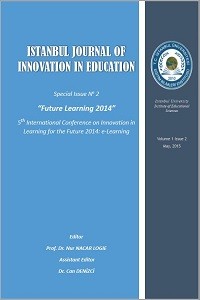Öz
Besides being imported to all of the areas in our lives, computers have a very important effect on all age groups. With the effect of the high-speed learning, in addition to using every kind of technological improvement easily, it can be observed that their speed of integrating those improvements into their lives is at a surprising level. In this study, behavior patterns of children, between the age of 12-15, in the first phase of a technological fact has been observed and worked on. “Cloud Computing” has been chosen as a fact that they will first face with. Firstly, a test has been given to the children in order to find out if they have any idea about the fact. After that, a presentation has been made about the fact chosen and then by applying a last test, it has been tried to find out how they comprehend the new fact. The data has been observed by “definitional statistic method” and “Depended Groups T-Test” using SPSS 21.0 software, and the results have been interpreted. The results show how fast children are in integrating new technology into their lives. In addition, the results include the details about the children’s viewpoint and sense.
Anahtar Kelimeler
Human computer interaction technological improvement computer usage cloud computing
Kaynakça
- ALAKOÇ, Z., “Matematik Öğretiminde Teknolojik Modern Öğretim Yaklaşımları”, The Turkish Online Journal of Educational Technology – TOJET January 2003 ISSN: 1303-6521 volume 2 Issue 1 Article.
- Bransford, 1. D.; Brown, A. C.; & Cocking, R. R. (1999). How people learn: Brain, mind, experience and school. Washington D.C: National Academy Press. Retrieved May 4,200] from the World Wide Web: <http://www.nap.edu/openbo- ok/0309065577/htmJ/ index.htm>.
- Clement, D. H. (1999). Young children and technology. In dialogue on early childhood science, mathematics and technology education. Washington D. C: American Association for the Advancement of Science Project 206].
- Dodge, D. T. ve Colker, L. J. (1995). (3rd. [‘’AI.).The creative curriculum for early childhood education. Teaching Staker. Ine. Washington. D.C.
- Elikind, David (1999), Çocuk ve Toplum Gelişim ve Eğitim Üzerine Denemeler, (Çev: Demet Öngen), Ankara Üniversitesi Çocuk Kültürü Araştırma ve Uygulama Merkezi Yayınları, Ankara.
- Healy, J. M. (1998). Understanding TV’s effect on developing brain. AAP News: The Official News Magazine of the American Academy of Pediatrics: http://www.aap.org/advocacy/chm98.nws.htm (4 Mayıs 2000).
- Odabaşı, F. (2005). Parent’s Views on Internet Use. The Turkish Online Journal of Educational Technology-TOJET, 3(1).
- Papert, S. (1980). Mindstorms: Children, microcomputers and powerful ideas. New York: Basic Books.
- Siraj - Blatchford, J. & Siraj - Blatchford, i. (2001). Guidance for appropriate technology education in early childhood. <http://www.ioe.ae.ukledVdatee> (20. 7.2002).
- Small, G.W., & Vorgan, G. (2008). IBrain: Surviving the technological alteration of the modern mind. New York: Collins Living.
- TÜİK (2011, Ağustos). 2011 yılı hanehalkı bilişim teknolojileri kullanım araştırması (Sayı 170). Ankara: T.C. Başbakanlık Türkiye İstatistik Kurumu. http://www.tuik.gov.tr/ PreHaberBultenleri .do?id=8572 adresinden 10 Mart 2012 tarihinde erişilmiştir.
- Van Rompaey, V., Roe, K. ve Struys, K. (2002). Children’s influence on Internet access at home, information. Communication and Society, 5(2), 189–206.
- Woodard EH & Gridina N. (2000). Media In The Home. The Fifth Annual Survey Of Parents And Children: http://www.appcpenn.org/mediainhome/survey/survey7.pdf
Öz
Kaynakça
- ALAKOÇ, Z., “Matematik Öğretiminde Teknolojik Modern Öğretim Yaklaşımları”, The Turkish Online Journal of Educational Technology – TOJET January 2003 ISSN: 1303-6521 volume 2 Issue 1 Article.
- Bransford, 1. D.; Brown, A. C.; & Cocking, R. R. (1999). How people learn: Brain, mind, experience and school. Washington D.C: National Academy Press. Retrieved May 4,200] from the World Wide Web: <http://www.nap.edu/openbo- ok/0309065577/htmJ/ index.htm>.
- Clement, D. H. (1999). Young children and technology. In dialogue on early childhood science, mathematics and technology education. Washington D. C: American Association for the Advancement of Science Project 206].
- Dodge, D. T. ve Colker, L. J. (1995). (3rd. [‘’AI.).The creative curriculum for early childhood education. Teaching Staker. Ine. Washington. D.C.
- Elikind, David (1999), Çocuk ve Toplum Gelişim ve Eğitim Üzerine Denemeler, (Çev: Demet Öngen), Ankara Üniversitesi Çocuk Kültürü Araştırma ve Uygulama Merkezi Yayınları, Ankara.
- Healy, J. M. (1998). Understanding TV’s effect on developing brain. AAP News: The Official News Magazine of the American Academy of Pediatrics: http://www.aap.org/advocacy/chm98.nws.htm (4 Mayıs 2000).
- Odabaşı, F. (2005). Parent’s Views on Internet Use. The Turkish Online Journal of Educational Technology-TOJET, 3(1).
- Papert, S. (1980). Mindstorms: Children, microcomputers and powerful ideas. New York: Basic Books.
- Siraj - Blatchford, J. & Siraj - Blatchford, i. (2001). Guidance for appropriate technology education in early childhood. <http://www.ioe.ae.ukledVdatee> (20. 7.2002).
- Small, G.W., & Vorgan, G. (2008). IBrain: Surviving the technological alteration of the modern mind. New York: Collins Living.
- TÜİK (2011, Ağustos). 2011 yılı hanehalkı bilişim teknolojileri kullanım araştırması (Sayı 170). Ankara: T.C. Başbakanlık Türkiye İstatistik Kurumu. http://www.tuik.gov.tr/ PreHaberBultenleri .do?id=8572 adresinden 10 Mart 2012 tarihinde erişilmiştir.
- Van Rompaey, V., Roe, K. ve Struys, K. (2002). Children’s influence on Internet access at home, information. Communication and Society, 5(2), 189–206.
- Woodard EH & Gridina N. (2000). Media In The Home. The Fifth Annual Survey Of Parents And Children: http://www.appcpenn.org/mediainhome/survey/survey7.pdf
Ayrıntılar
| Birincil Dil | İngilizce |
|---|---|
| Bölüm | Editorial and Advisory Board |
| Yazarlar | |
| Yayımlanma Tarihi | 31 Ekim 2018 |
| Yayımlandığı Sayı | Yıl 2015 Cilt: 1 Sayı: 2 |


